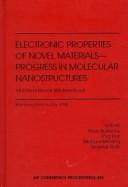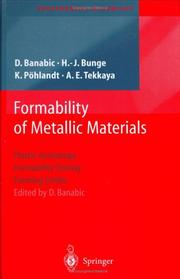| Listing 1 - 10 of 32 | << page >> |
Sort by
|
Book
ISBN: 0721010326 Year: 1976 Publisher: London : Cement and concrete association,
Abstract | Keywords | Export | Availability | Bookmark
 Loading...
Loading...Choose an application
- Reference Manager
- EndNote
- RefWorks (Direct export to RefWorks)
Concrete. --- Workability --- Workability
Book
ISBN: 9780323996778 Year: 2023 Publisher: London, England : Academic Press,
Abstract | Keywords | Export | Availability | Bookmark
 Loading...
Loading...Choose an application
- Reference Manager
- EndNote
- RefWorks (Direct export to RefWorks)
Ductility and Formability of Metals: A Metallurgical Engineering Perspective uses metallurgical, mechanical and physical principles and concepts to explain ductility while emphasizing the influence of material microstructure on damage mechanisms. Focusing on steel, aluminum, copper, titanium and magnesium alloys, the book examines the strain hardening behaviors of these metals and alloys, the influence of strain rate and temperature, and ductile fracture mechanics. Hot plastic deformation is covered with special consideration given to its interplay with recrystallization phenomena. Other phenomena such as Dynamic Strain Ageing (DSA) and Adiabatic Shear Banding (ASB) are discussed, and metal working applications such as forging, extrusion and machining are included throughout. Methods for control of ductile cracks in metal parts resulting from rolling, forging, extrusion, drawing, and sheet metal forming are also outlined. Provides an overview on the plastic deformation behavior and ductile fracture of steel, aluminum, copper, titanium and magnesium alloys Illustrates the influence of microstructure on yield behavior, strain hardening of metals, and the influence of strain rate and temperature Covers the role of the strain hardening coefficient (n), strain rate index (m), Dynamic Strain Ageing (DSA), and Adiabatic Shear Banding (ASB) Metalworking applications are provided throughout, including forging, rolling, extrusion, wire drawing, sheet metal forming and machining.
Metals --- Bendability of metals --- Deformability of metals --- Formability of metals --- Workability of metals --- Metal-work --- Formability. --- Ductility.
Book
ISBN: 3031226615 3031226607 Year: 2023 Publisher: Cham, Switzerland : Springer Nature Switzerland AG,
Abstract | Keywords | Export | Availability | Bookmark
 Loading...
Loading...Choose an application
- Reference Manager
- EndNote
- RefWorks (Direct export to RefWorks)
This collection presents fundamentals and the current status of friction stir welding (FSW) and solid-state friction stir processing of materials and provides researchers and engineers with an opportunity to review the current status of the friction stir related processes and discuss the future possibilities. Contributions cover various aspects of friction stir welding and processing including their derivative technologies. Topics include, but are not limited to: • Derivative technologies • High-temperature applications • Industrial applications • Dissimilar alloys and/or materials • Lightweight alloys • Simulation • Characterization • Non-destructive examination techniques .
Friction stir welding. --- Metals --- Formability. --- Bendability of metals --- Deformability of metals --- Formability of metals --- Workability of metals --- Metal-work --- FSW (Welding) --- Welding
Book
ISBN: 9780128137291 0128137304 0128137290 9780128137307 Year: 2017 Publisher: Oxford, United Kingdom Butterworth-Heinemann
Abstract | Keywords | Export | Availability | Bookmark
 Loading...
Loading...Choose an application
- Reference Manager
- EndNote
- RefWorks (Direct export to RefWorks)
Friction stir welding. --- Metals --- Machining. --- Formability. --- Materials --- Machine-shop practice --- Manufacturing processes --- Cutting --- Machine-tools --- Bendability of metals --- Deformability of metals --- Formability of metals --- Workability of metals --- Metal-work --- FSW (Welding) --- Welding --- Machining
Book
ISBN: 9789811913488 Year: 2022 Publisher: Singapore Springer Nature Singapore :Imprint: Springer
Abstract | Keywords | Export | Availability | Bookmark
 Loading...
Loading...Choose an application
- Reference Manager
- EndNote
- RefWorks (Direct export to RefWorks)
Metal-work. --- Metals --- Deformations (Mechanics) --- Elastic solids --- Mechanics --- Rheology --- Strains and stresses --- Structural failures --- Bendability of metals --- Deformability of metals --- Formability of metals --- Workability of metals --- Metal-work --- Metalwork --- Decoration and ornament --- Manufacturing processes --- Formability. --- Coloring

ISBN: 1563968088 Year: 1998 Volume: 442
Abstract | Keywords | Export | Availability | Bookmark
 Loading...
Loading...Choose an application
- Reference Manager
- EndNote
- RefWorks (Direct export to RefWorks)
67.014 <063> --- 67.017 <063> --- Carbon --- Fullerenes --- Molecular structure --- Nanostructured materials --- -Nanomaterials --- Nanometer materials --- Nanophase materials --- Nanostructure controlled materials --- Nanostructure materials --- Ultra-fine microstructure materials --- Microstructure --- Nanotechnology --- Structure, Molecular --- Chemical structure --- Structural bioinformatics --- Group 14 elements --- Light elements --- Chemical constitution and properties of materials--Congressen --- Physical and mechanical properties, workability and serviceability of materials--Congressen --- Electric properties --- -Chemical constitution and properties of materials--Congressen --- 67.017 <063> Physical and mechanical properties, workability and serviceability of materials--Congressen --- 67.014 <063> Chemical constitution and properties of materials--Congressen --- -Structure, Molecular --- Nanomaterials --- Tubes --- Tubing --- Tubular goods --- Shells (Engineering) --- Materials --- Congresses --- Molecular electronics
Book
ISBN: 0124201830 012420113X 1306540976 9780124201132 9780124201835 Year: 2014 Publisher: Waltham, Massachusetts Oxford [England]
Abstract | Keywords | Export | Availability | Bookmark
 Loading...
Loading...Choose an application
- Reference Manager
- EndNote
- RefWorks (Direct export to RefWorks)
The use of friction stir processing to locally modify the microstructure to enhanced formability has the potential to alter the manufacturing of structural shapes. There is enough research to put together a short monograph detailing the fundamentals and key findings. One example of conventional manufacturing technique for aluminum alloys involves fusion welding of 5XXX series alloys. This can be replaced by friction stir welding, friction stir processing and forming. A major advantage of this switch is the enhanced properties. However qualification of any new process involves a series of tests to prove that material properties of interest in the friction stir welded or processed regions meet or exceed those of the fusion welded region (conventional approach). This book will provide a case study of Al5083 alloy with some additional examples of high strength aluminum alloys. Demonstrates how friction stir processing enabled forming can expand the design space by using thick sheet/plate for applications where pieces are joined because of lack of formability Opens up new method for manufacturing of structural shapes Shows how the process has the potential to lower the cost of a finished structure and enhance the design allowables.
Machining -- Handbooks, manuals, etc. --- Stir welding. --- Welding -- History. --- Friction stir welding --- Metals --- Mechanical Engineering --- Engineering & Applied Sciences --- Industrial & Management Engineering --- Formability --- Friction stir welding. --- Machining --- Formability. --- Materials --- Machine-shop practice --- Manufacturing processes --- Cutting --- Machine-tools --- Bendability of metals --- Deformability of metals --- Formability of metals --- Workability of metals --- Metal-work --- FSW (Welding) --- Welding
Book
ISBN: 9783662463123 3662463113 9783662463116 3662463121 Year: 2015 Publisher: Berlin, Heidelberg : Springer Berlin Heidelberg : Imprint: Springer Vieweg,
Abstract | Keywords | Export | Availability | Bookmark
 Loading...
Loading...Choose an application
- Reference Manager
- EndNote
- RefWorks (Direct export to RefWorks)
60 novel approaches in metal forming are presented and explained in detail. Contributions from acknowledged international scientists representing the state-of-art in metal forming open a general view on recent results and a clear view on demands for new research initiatives.
Engineering. --- Manufacturing, Machines, Tools. --- Mechanical Engineering. --- Mechanical engineering. --- Machinery. --- Ingénierie --- Génie mécanique --- Machines --- Mechanical Engineering --- Engineering & Applied Sciences --- Mechanical Engineering - General --- Metal-work --- Metals --- Technological innovations. --- Formability. --- Engineering, Mechanical --- Bendability of metals --- Deformability of metals --- Formability of metals --- Workability of metals --- Metalwork --- Manufacturing industries. --- Machines. --- Tools. --- Engineering --- Machinery --- Steam engineering --- Decoration and ornament --- Manufacturing processes --- Coloring --- Manufactures. --- Manufacturing, Machines, Tools, Processes. --- Manufactured goods --- Manufactured products --- Products --- Products, Manufactured --- Commercial products --- Manufacturing industries

ISBN: 3540679065 3642087507 3662040131 Year: 2000 Publisher: Berlin : Springer,
Abstract | Keywords | Export | Availability | Bookmark
 Loading...
Loading...Choose an application
- Reference Manager
- EndNote
- RefWorks (Direct export to RefWorks)
After a brief introduction into crystal plasticity,the fun- damentals of crystallographic textures and plastic anisotro- py, a main topic of this book, are outlined. A large chapter is devoted to formability testing both for bulk metal and sheet metal forming. For the first time testing methods for plastic anisotropy of round bars and tubes are included. A profound survey is given of literature about yield criteria for anisotropic materials up to most recent developments and the calculation of forming limits of anisotropic sheet me- tal. Other chapters are concerned with properties of workpieces after metal forming as well as the fundamentals of the theory of plasticity and finite element simulation of metal forming processes. The book is completed by a collection of tables of international standards for formability testing and of flow curves of metals which are most commonly used in metal forming. It is addressed both to university and industrial readers.
Metal-work --- Metals --- -Metals --- -Metallic elements --- Chemical elements --- Ores --- Metallurgy --- Metalwork --- Decoration and ornament --- Manufacturing processes --- Formability --- Plastic properties --- Coloring --- Metal-work. --- Formability. --- Plastic properties. --- -Formability --- Bendability of metals --- Deformability of metals --- Formability of metals --- Workability of metals --- Metals. --- Manufactures. --- Mechanics. --- Mechanics, Applied. --- Metallic Materials. --- Manufacturing, Machines, Tools, Processes. --- Solid Mechanics. --- Applied mechanics --- Engineering, Mechanical --- Engineering mathematics --- Classical mechanics --- Newtonian mechanics --- Physics --- Dynamics --- Quantum theory --- Manufactured goods --- Manufactured products --- Products --- Products, Manufactured --- Commercial products --- Manufacturing industries --- Metallic elements
Book
Abstract | Keywords | Export | Availability | Bookmark
 Loading...
Loading...Choose an application
- Reference Manager
- EndNote
- RefWorks (Direct export to RefWorks)
The current production and consumption models of building materials are causing severe environmental and social problems worldwide. In this sense, construction and demolition waste (C&DW) are part of the problem and can be part of the solution, particularly in developing countries where the construction industry is growing very rapidly. Although many efforts have been made by stakeholders to increase the use of C&DW in construction materials, articulated efforts are required at global, national, and local scales to develop truly sustainable construction sectors. Therefore, this e-book, which is based on the “Special Issue on Construction and Demolition Waste: Challenges and Opportunities”, is an effort to articulate knowledge on novel and innovative building materials using C&DW and management systems to develop circular economy models (CE) for the construction sector. In this e-book, it is concluded that even though the valorization of C&DW has been developed worldwide, more incentives need to be provided to really convert the local and national construction chains in sustainable sectors, which appropriate the circular economy for production and consumption systems that imrpove, at the least, efficiency in terms of materials, water and energy use.
Technology: general issues --- History of engineering & technology --- Conservation of buildings & building materials --- construction and demolition wastes --- alkali-activated materials --- recycling --- binder --- recycled aggregates --- paving stones --- aggregates --- C& --- DW --- sustainability --- mechanical properties --- concrete --- demolition waste --- management --- life cycle assessment --- circular economy --- recycled concrete aggregate --- recycled aggregate concrete --- residual mortar --- reusing --- workability --- compressive strength --- pavement --- green deal --- construction and demolition waste --- quantification --- waste management --- re-use --- material stock analysis --- multi-criteria decision-making --- local authorities --- urban metabolism --- interview --- building --- recycled concrete --- carbonation --- construction and demolition waste (C&DW) --- construction --- municipal solid waste incineration bottom ash --- supplementary cementitious material
| Listing 1 - 10 of 32 | << page >> |
Sort by
|

 Search
Search Feedback
Feedback About UniCat
About UniCat  Help
Help News
News